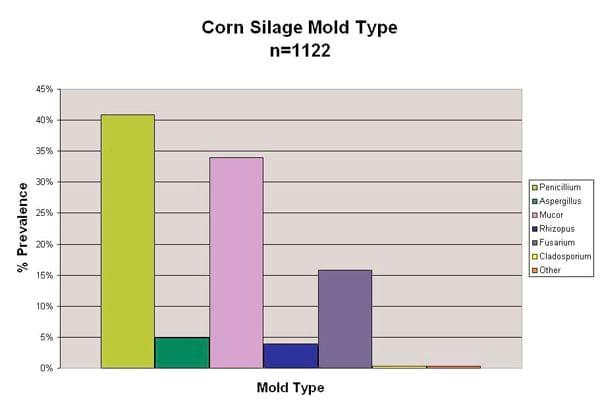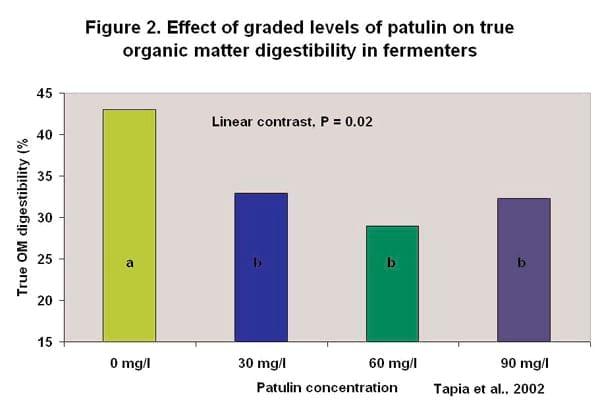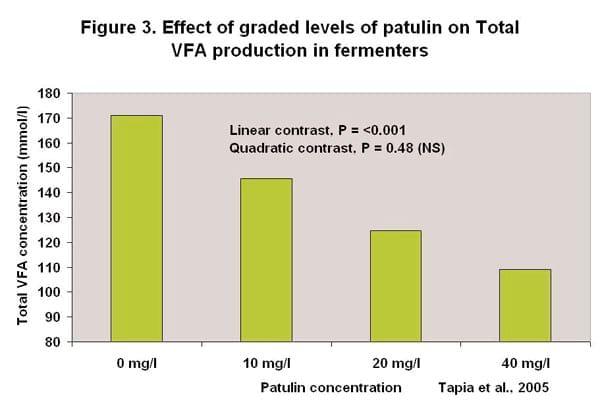Mycotoxins in Rumen
Can Mycotoxins affect Rumen Fermentation?
Published: October 1, 2012
By: Nicholas Adams, Global Sales Manager, Alltech Mycotoxins
As producers, nutritionists and veterinarians we are used to seeing molds on the farm. Molds are ubiquitous in the environment and it has been well documented that some of these molds have the ability to produce poisons known as mycotoxins. Because of their ability to survive many environmental conditions, different species of molds have the ability to grow on the crop in the field pre-harvest, during harvest and also post harvest. It has also been documented that mycotoxin production can occur at all of these stages.
Many adverse effects of mycotoxins have been noted within cows including reduced feed intake, reduced nutrient utilization, altered rumen fermentation, suppressed immunity, altered reproduction, tissue irritation and cell death. Although rumen fermentation is listed in these effects, it is not typically the first thing people think of when discussing the subject of mycotoxins. When the literature is reviewed, however, it makes for interesting reading.
The Current Thought Process
At the moment anybody who feels mycotoxins are having a negative impact on health and performance, and who would like to have feeds analyzed, typically send a TMR or selected commodities for a mycotoxin screen. This usually involves testing for four or five key mycotoxins including Vomitoxin (DON), Zearalenone, T-2 Toxin, Fumonisin and Aflatoxin. Under North American conditions it is highly likely that all of these mycotoxins, if present, have been produced in the field prior to the crop being harvested. In recent years, however, it has become more widely known that during storage the Penicillium species of mold are particularly prevalent and bring with them some interesting effects.
The Prevalence of Penicillium Molds
It is clear from data collected at Dairyland Laboratories over the past few seasons that the prevalence of Penicillium molds outnumbers other species in stored feed materials. Figure 1 illustrates this for corn silage samples taken during this past growing season, however when one reviews other feedstuffs and other seasons a similar picture is noted. This agrees with research from a number of authors all of whom have found Penicillium mold to be the most prevalent species particularly in silages.

While Penicillium molds have traditionally been thought of as storage related, work from Pennsylvania has shown that they can grow and produce mycotoxins pre-harvest. While this is likely it remains true that the main Penicillium molds associated with dairy cows thrive under acidic, low oxygen environments which make fermented feeds an ideal home for them.
What should I be looking for in my silage?
Researchers in Germany in the late 1990's showed that the presence of Penicillium mold in silage was a useful indicator as to the presence of Penicillium mycotoxins. This research found that 21 out of 24 visibly moldy silage bunks contained the Penicillium mycotoxin Roquefortine C, while only 6 of the visibly un-moldy bunks contained the same mycotoxin. In this regard they concluded that a positive identification of Penicillium mold within a silage bunk would be a good indicator as to the presence of Penicillium mycotoxins. While Roquefortine C and other Penicillium mycotoxins have been linked to symptoms such as paralysis, abortion and immunosupression, these have yet to be proven under controlled research conditions.

The effects of Penicillium Mycotoxins on Rumen Fermentation
Most of the work in this area relates to the impact of Patulin on rumen fermentation. Researchers in North America conducted two experiments where Patulin was added to continuous flow fermenters every 12 hours for a three day period. The two experiments looked at Patulin levels from 0 to 90 and 0 to 40 mg respectively, with each level being added at the 12 hour interval. The conclusion of these experiments was that Patulin can negatively affect rumen fermentation as seen by reduced neutral detergent fiber (NDF) and acid detergent fiber (ADF) digestibility, reduced true organic matter digestibility (Figure 2) as well as a reduction of crude protein and nitrogen flow. Researchers in France came to the same conclusion when they added similar levels of Patulin to a batch culture system and noted a reduction in dry matter degradation, gas production and volatile fatty acid production (Figure 3). Although these researchers commented that the half life of patulin within the rumen was likely in the order of four hours, they noted that Patulin may be more toxic within the rumen than initially thought.
Putting the pieces together
There have been no truly definitive studies on the impact of Penicillium mycotoxins within dairy cows. And to further confuse matters there are no routine commercial tests available for us to get a better handle on the level of Penicillium mycotoxins in forages on a consistent basis. That said, the research done to date very much points to the fact that mycotoxins such as Patulin do have the ability to alter rumen fermentation. Penicillium molds in feedstuffs are a good indicator of the presence of Penicillium mycotoxins. Because of the fact that Penicillium molds are widespread on dairy farms in North America, particularly in fermented feedstuffs and other stored ingredients, they should serve as indicators of Penicillium mycotoxins for producers, nutritionists and veterinarians alike.

Summary
The bottom line for producers should be that where visible mold is seen growing on stored feeds or in silage bunks it should be a red flag for potential health and performance issues. This is particularly the case when one bears in mind that the levels of Penicillium mycotoxins that have been found in and around the moldy parts of different feeds have been particularly high which very much supports the concept of pitching spoiled feed material as this is heavily contaminated with both molds and mycotoxins.
When it comes to managing the challenge of molds and mycotoxins on the dairy there are many factors with pre- and postharvest origins to take into account. In a paper published in 2007, Dr. Jean-Pierre Jouany highlighted 21 different interventions that may impact the level of mycotoxin in a finished feed and suggested that being able to control each one of these steps was impossible. With this in mind he noted that one step within these21 had the possibility of negating all of the previous steps. This was the addition of an organic mycotoxin adsorbent to the diet which has the ability to negate to some extent all of the previous steps. Ultimately when all is said and done we will have to cope with molds and mycotoxins on the dairy farm and the use of a proven mycotoxin adsorbent can help to offset the fact that there is likely some level of mycotoxin in each and every diet.
Related topics:
Authors:
Alltech
Recommend
Comment
Share
25 de marzo de 2013
Very good information on effect of mycotoxins on fermentation. This defenitivelly affect milk production.
Recommend
Reply
13 de febrero de 2013
Very informative article. Does anyone know the proper mechanism by which mycotoxins, particularly aflatoxin, ochratoxin, ZON and DON, affect fermentation?
Recommend
Reply
31 de enero de 2013
That was a informative article regarding mycotoxin effect especially Patualin on VFA. Is there any information regarding the effect of other mycotoxins on VFA production?
Recommend
Reply
18 de octubre de 2012
Very Good information about Mycotoxins and Rumen Fermentation.I hope remedy will be sought for the public health interest.
Recommend
Reply
7 de octubre de 2012
Excellent research article influences bovine commercial milk production and help veterinarians to take appropriate decisions to improve economy of farmers.
Recommend
Reply
Recommend
Reply

Would you like to discuss another topic? Create a new post to engage with experts in the community.







